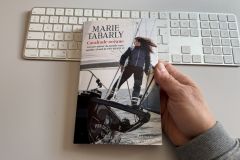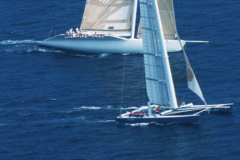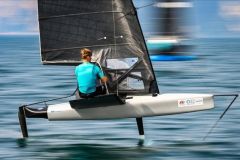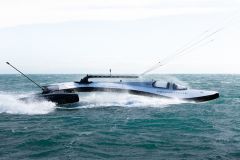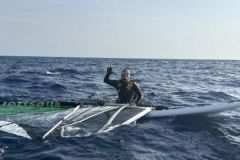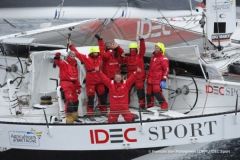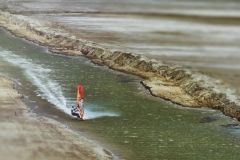Attempt the North Atlantic crossing record, from West to East
Three weeks after his victory in The Transat Bakerly, François Gabart started this Wednesday 1 er june a period of stand-by in view of his record attempt on the North Atlantic crossing, from west to east. With his router, Jean-Yves Bernot, the skipper of the Macif trimaran is watching for the right weather window to set off on this record, which has been held by Francis Joyon since 2003 (5 days 2 hours 56 minutes and 10 seconds)
Since this first solo victory on the Macif trimaran, François Gabart has been able to recover from the fatigue accumulated during these 8 days of racing. But he has also continued to train to prepare for his crossing of the New York - Lizard Cape (southwestern tip of England.)
"For the past few days, I've been completely in record mode, I feel like I'm at the start of a race, there's clearly some excitement. MACIF is in perfect condition from a structural point of view and I'm really happy with the deck plan set up. It's what I expected and it's a clear improvement on last year's version explains the sailor from Charente.

A first for François Gabart
Rather used to racing, this record will be a first that the sailor is looking forward to "I like to break new ground, in a field, that of the record, and therefore of speed under sail, which is quite ultimate. The MACIF trimaran provides exceptional sensations when she goes fast. I had a taste of it on The Transat bakerly, in conditions that were not optimal, I am eager to see what it can give with a more chosen weather. Some people tell me that nothing beats the competition, but in the human and sporting commitment, the exercise of the record is exceptional because it is without limits."
Whatever the outcome, this experience will allow the sailor to evolve further.

Wait for the right weather window
"I'm ready to leave. We are now waiting for the right weather window with Jean-Yves Bernot. For now, nothing is in the pipeline for the first week of June." And just what is the ideal window? Here are the sailor's explanations "Stable wind, 20-30 knots of SW'ly ahead of a low, and a tidy sea. It's a dream scenario, but as our stand-by period is fairly short (MACIF must be back in Brest on July 12 to take part in the Fêtes Maritimes), we won't necessarily have an ideal window. We will have to be opportunistic and know how to make the most of the conditions."

The first indicated that no departure was envisaged; the second that a potential window of 3-4 days was emerging; level 3 confirmed a departure window and led François Gabart and part of his team to fly to New York. The fourth confirms the departure within 24 hours and sets the boat sailing towards the line, anchored at the Ambrose Light buoy, some 20 miles from New York.
The skipper knows that he will have to be patient. "It's also part of being a sailor to wait for the wind. I've sailed in the Olympics for years, there have been times when I've spent entire days in a parking lot waiting for the wind to come in or calm down."

A time difficult to beat
The North Atlantic Record single-handed from west to east is a short and long challenge in terms of endurance and intensity, which has passed through the hands of many sailors. The first to attempt it was Bruno Peyron in 1987 with a crossing of 11 days 11 hours 46 minutes.
Since then, the reference time for the 2,880-mile course has been divided by two and has belonged to Florence Arthaud (1990), Bruno Peyron again (1992), Laurent Bourgnon (1994), Francis Joyon (2005) and Thomas Coville (2008). Since 2013, it is Francis Joyon who holds the record in 5 days 2 hours, 56 minutes and 10 seconds, at an average real speed of 26.20 knots (23.30 theoretical speed on the great circle route, the most direct route).
"The time is complicated to beat, but my boat clearly has the potential. For that to happen, you need three factors: a good weather window, the man to be able to manage the boat at high speed and a bit of luck. It would be great to get under the five-day mark explains François Gabart.
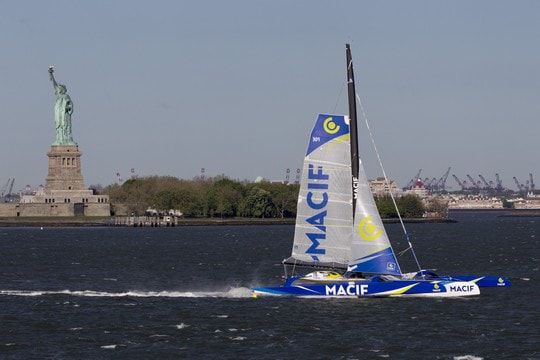
Photo credits: Alexis Courcoux / Macif






